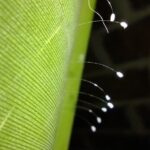Below is an article reproduced with permission from Brazos County Master Gardener Todd Riggle (Class of 2022). All images are copyright Todd Riggle.
It all began about the last week of May 2024 with aphid hordes descending upon the cucumber vines. A week later they were sucking the life out of my melon plants in the same 5-ft x 24-ft raised bed. The leaves were looking terrible (Ex 1) and I was getting worried. I put on my reading glasses and combined with a magnifying glass, inspected the leaf undersides. Yes, there were massive amounts of aphids, but there were also a variety of beneficials starting to get a foothold. For the good guys, there were green lacewing eggs perched safely on their delicate stalks (Ex 2), lady beetle egg clusters and a multitude of tiny flies too small to get a good identification. I noticed aphid mummies, indicating the presence of parasitoids and a few Asian lady beetles moving about, munching on their average of 100 aphids a day. For management, I had 3 choices: pull out all the melons and start over (undesirable); spray water blasts or insecticide on the leaf undersides (putting beneficials at risk, also undesirable); or just let nature take its course and let the good guys battle it out with the forces of evil. Who would prevail? It was a bold move, allowing an entomological version of a Waterloo in my own backyard, but that’s what was decided upon. I felt I had the luxury of making this decision because I had just planted bed number 2 with melons and was sure to at least have some crop from that bed. More about that later.
The month of June rolled along with the leaves looking, to the casual observer, more and more like death warmed over. True, this battle cost me an early crop, but the things going on in the miniature world of insects were fascinating. I witnessed lacewing larvae (Ex 3) piling on their backs the bodies of victims and other trash to look too big to eat by another predator. More aphid mummies appeared. Aphid eating machines like syrphid fly larvae (Ex 4) and numerous lady beetle larvae (Ex 5), consuming 600 to 1200 aphids in 3-6 weeks, were happily doing what they do best. An assassin bug with an apparent attitude appeared, acting as if he’d done it all himself. V-Day occurred the first week of July with the good guys declaring total victory. New growth had started to appear, and it was aphid free (Ex 6). It is now the end of July, and the melon leaves are pristine and abundantly verdant. Not an aphid in sight and not a shot was fired. Lady beetles continue to cruise the foliage, doing last minute clean up. There are blooms galore and to date about 20+ melons getting close to “slipping” off the vine. Success!
What happened in bed number 2? The aphids descended upon that bed in a lightning blitz movement about mid-July. The plants looked horrible, and the honey dew was disgusting. I sprayed with high pressure water twice and insecticide twice, which cost me the help of any beneficials. It was a losing battle without beneficial predators and parasitoids. Without the lady beetle’s crew and cast there would have been no melon show. Bed two was cleaned out July 28 and put in the bin for collection.






